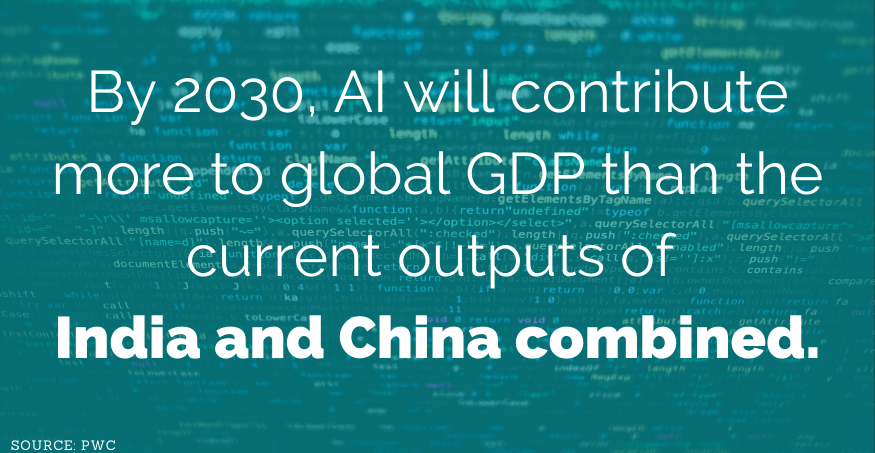AI & Disability: Weeding Out Bias, Finding Opportunity
Artificial intelligence has changed the way we work. It’s only getting stronger.
By 2030, artificial intelligence will contribute more to global GDP than the current combined outputs of China and India together, according to a recent study from PwC.
But despite its massive potential, exponential growth, and rapid adoption by companies around the world, research has revealed that AI can sometimes amplify racial bias, gender bias, and bias against people living with disabilities.
So how can the Human Services community harness the power of AI rather than fall victim to it? The answer starts with understanding the problem.

How does artificial intelligence affect people living with disabilities?
Technology has been providing tools and opportunities for people living with disabilities for decades from wheelchairs to hearing aids to voice recognition programs and beyond. The rapid rise of AI offers a whole new array of solutions that could benefit the Human Services community.
But just as studies have shown that the use of AI can have serious biases in regards to race and gender, it can also have a negative impact on people living with disabilities. For example, a company called HireVue that offers AI video-interviewing services to screen job candidates based on speech patterns and facial movements was found to be massively discriminatory against people living with disabilities such as deafness, blindness, and speech disorders.
This is just one of countless examples where the AI dataset did not include nor consider the entirety of the people it was meant to serve. For better data analysis, we need better data. That means making sure that when an AI program is being built to serve “people,” people living with disabilities are an integral part of that equation.
Innovations driven by the needs of people living with disabilities are often forging a path for the future, advancing society in ways people without disabilities cannot yet imagine.
What else factors into AI systems having a narrow view of the world? Having a narrow subset of people designing the AI. According to a report from CBS, 80% of AI professors are men, while women and people of color make up a tiny fraction of AI researchers at some of the biggest tech companies. It’s not enough to ask AI to include people with disabilities. To get more holistic—and accurate—readings from artificial intelligence, we need a more diverse set of people designing the systems themselves.
How can artificial intelligence help people living with disabilities?
Even as we wrestle with bias in AI, we’re seeing plenty of innovations and opportunities that are improving the lives of people living with disabilities.
In early 2019, Microsoft announced its AI for Accessibility program, investing $25 million towards AI projects that “empower people with disabilities with tools that support independence and productivity, as technology rapidly changes the way we live, learn, and work.”
The future for AI and people living with disabilities looks brighter each day, as the Human Services community continues to advocate fiercely for representation in AI systems.
Another innovation, Voiceitt, offers speech recognition technology to support communication for people with speech impediments, including those living with conditions like cerebral palsy, Parkinson’s, and Down’s syndrome. Voiceitt utilizes machine learning to learn speakers’ unique speech patterns, then translate their speech into an output of audio or text, with the goal of “increasing independence for people of any ability, building deeper human connection and creating more inclusive and accessible communities.”
Even our everyday in-home AI products are getting better at serving people living with disabilities, with Amazon’s Alexa, for example, learning to respond in sign language over webcam. Or, better yet, people living with disabilities are discovering how to use AI to their advantage, such as using Siri’s shortcuts capability to streamline commands—making the process easier for people with speech impairments.
What comes next for AI and people living with disabilities?
While the problems and implicit biases of artificial intelligence are far from solved, the future for AI and people living with disabilities looks brighter each day, as the Human Services community continues to advocate fiercely for representation in AI systems.
And as AI innovators look to the future, they should see the inclusion of people living with disabilities not merely as a necessity or a way to improve the accuracy of their data, but as an opportunity to benefit everyone.
Closed captioning started as a means to support people who couldn’t hear but is now used by anyone who wants to watch a video without sound. One of the original goals for typewriters was to help people living with disabilities communicate more easily.
Innovations driven by the needs of people living with disabilities are often forging a path for the future, advancing society in ways that people without disabilities cannot yet imagine.
So it is with artificial intelligence. Once AI starts being designed to fully embrace our entire society, that’s when its true power will be unleashed.




Leave a Reply
Want to join the discussion?Feel free to contribute!